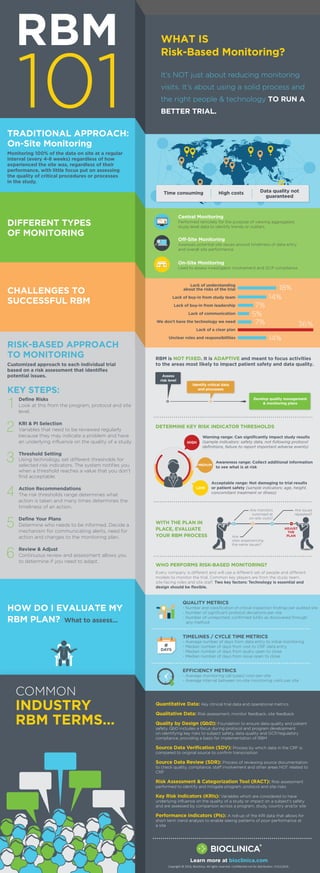RBM 101 Infographic FINAL 2016
- 1. WHAT IS Risk-Based Monitoring? It’s NOT just about reducing monitoring visits. It’s about using a solid process and the right people & technology TO RUN A BETTER TRIAL. RBM 101TRADITIONAL APPROACH: On-Site Monitoring Monitoring 100% of the data on site at a regular interval (every 4-8 weeks) regardless of how experienced the site was, regardless of their performance, with little focus put on assessing the quality of critical procedures or processes in the study. DIFFERENT TYPES OF MONITORING Central Monitoring Performed remotely for the purpose of viewing aggregated, study-level data to identify trends or outliers Off-Site Monitoring Assesses potential site issues around timeliness of data entry and overall site performance On-Site Monitoring Used to assess investigator involvement and GCP compliance CHALLENGES TO SUCCESSFUL RBM Customized approach to each individual trial based on a risk assessment that identifies potential issues. RBM is NOT FIXED. It is ADAPTIVE and meant to focus activities to the areas most likely to impact patient safety and data quality. DETERMINE KEY RISK INDICATOR THRESHOLDS WITH THE PLAN IN PLACE, EVALUATE YOUR RBM PROCESS ADJUST THE PLAN Warning range: Can significantly impact study results (sample indicators: safety data, not following protocol definitions, failure to report important adverse events) Awareness range: Collect additional information to see what is at risk Lack of understanding about the risks of the trial Lack of buy-in from study team Lack of buy-in from leadership Lack of communication We don't have the technology we need Lack of a clear plan Unclear roles and responsibilities 18% 14% 14% 36% 7% 7% 5% Are issues repeated? Are sites experiencing the same issues? Are monitors surprised at on-site visits? Every company is different and will use a different set of people and different models to monitor the trial. Common key players are from the study team, site-facing roles and site staff. Two key factors: Technology is essential and design should be flexible. Acceptable range: Not damaging to trial results or patient safety (sample indicators: age, height, concomitant treatment or illness) RISK-BASED APPROACH TO MONITORING KEY STEPS: Define Risks Look at this from the program, protocol and site level. KRI & PI Selection Variables that need to be reviewed regularly because they may indicate a problem and have an underlying influence on the quality of a study. Threshold Setting Using technology, set different thresholds for selected risk indicators. The system notifies you when a threshold reaches a value that you don’t find acceptable. Action Recommendations The risk thresholds range determines what action is taken and many times determines the timeliness of an action. Define Your Plans Determine who needs to be informed. Decide a mechanism for communicating alerts, need for action and changes to the monitoring plan. Review & Adjust Continuous review and assessment allows you to determine if you need to adapt. HIGH LOW MEDIUM WHO PERFORMS RISK-BASED MONITORING? HOW DO I EVALUATE MY RBM PLAN? QUALITY METRICS - Number and classification of critical inspection findings per audited site - Number of significant protocol deviations per site - Number of unreported, confirmed SAEs as discovered through any method TIMELINES / CYCLE TIME METRICS - Average number of days from data entry to initial monitoring - Median number of days from visit to CRF data entry - Median number of days from query open to close - Median number of days from issue open to close EFFICIENCY METRICS - Average monitoring (all types) cost-per-site - Average interval between on-site monitoring visits per site What to assess... $ # DAYS Quantitative Data: Key clinical trial data and operational metrics Qualitative Data: Risk assessment, monitor feedback, site feedback Quality by Design (QbD): Foundation to ensure data quality and patient safety. QbD includes a focus during protocol and program development on identifying key risks to subject safety, data quality and GCP/regulatory compliance, providing a basis for implementation of RBM Source Data Verification (SDV): Process by which data in the CRF is compared to original source to confirm transcription Source Data Review (SDR): Process of reviewing source documentation to check quality, compliance, staff involvement and other areas NOT related to CRF Risk Assessment & Categorization Tool (RACT): Risk assessment performed to identify and mitigate program, protocol and site risks Key Risk Indicators (KRIs): Variables which are considered to have underlying influence on the quality of a study or impact on a subject's safety and are assessed by comparison across a program, study, country and/or site Performance Indicators (PIs): A roll-up of the KRI data that allows for short term trend analysis to enable seeing patterns of poor performance at a site Copyright © 2016, Bioclinica. All rights reserved. Confidential not for distribution. V1JUL2016. Learn more at bioclinica.com COMMON INDUSTRY RBM TERMS... Time consuming High costs Data quality not guaranteed Develop quality management & monitoring plans Assess risk level Identify critical data and processes

